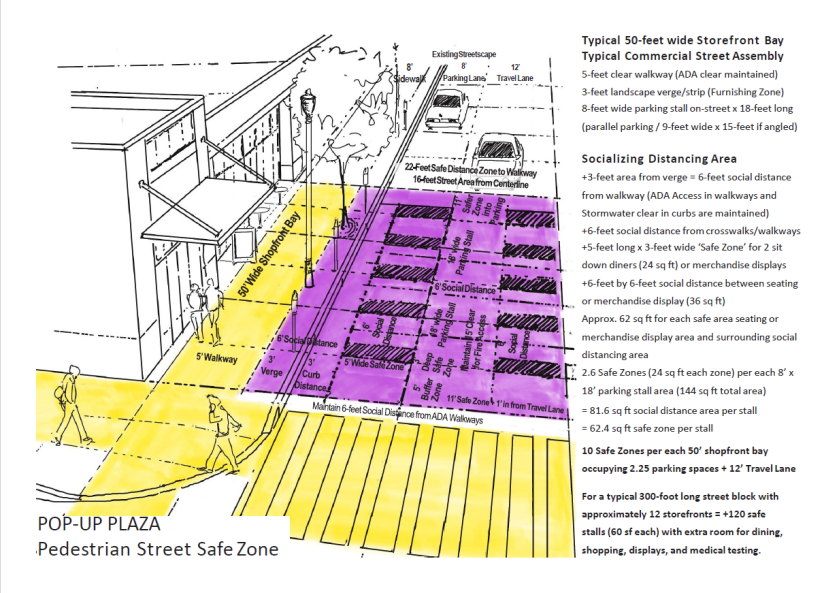
Three Types of Open Air Spaces

Pop Up Parklet

Pop Up Plaza

Pop Up San Diego Scenario

Pop Up Spaces Defined

Pop Up Plaza, Parklet and Full Block Plaza
These illustrations and site plans are intended to assist our cities in enabling open-air markets in streets and rights-of-way. A follow up to the Podcast interview I had with Andrew Keatts this week (click here), the math shows that a full block provides the most area to enable more dining and shopping to be located in neighborhood centers located every half-mile or so apart. These ‘streateries’ would be managed and operated by local Business Improvement Districts (BIDs) and Main Street organizations in order to be equitable across the city without it being shop by shop and coordinate efforts and resources (money) to enable us to have a safe place to go to dine in/out, shop in/out, and communicate with others.
San Diego simply doesn’t have enough local parks and plazas to handle the excess space needed to bring small businesses back to our neighborhoods. These places are intended to help small businesses reopen, as well as provide more public space to safely re-emerge from our homes and back into our neighborhoods. These standards would mitigate for social distancing while allowing the local shops to expand their capacity with the biggest issues to be planned for are conflicts between cars and people and maintaining socializing distancing.
The state is beginning to allow shops and restaurants to reopen at 50% capacity and still offer take out service. These plazas are intended to provide that other 50% capacity to help these businesses. In these standard 3-feet by 5-feet ‘safe zones,’ surrounded by a 6-feet social distancing area, are able to comfortably provide a table with two chairs, or a merchandise display, clothing racks, and a place to sit and wait for food while enjoying beverages in the summer time. They’re a safe relief value from the past 3 months of quarantine.
Importantly, American Disabilities Act standards are maintained. Stormwater runoff at the curb is maintained. And, a 15-foot clear fire access lane is maintained through the center of the streetscape as these spaces are marked off by tape and paint. The traffic barriers and reflective tape/paint costs money by the BIDs and local municipalities. The maintenance, cleaning, and daily operation will be a public-private partnership with local shops being active participants in managing these new public spaces. The shops that front onto the space, as well as in the immediate surrounding area, are able to benefit from this extra area and enhance the experience with lighting, signage, shade, seating, and sounds.
The National Association of City Transportation Officials (@NACTO) has recently shared its open Streets for Pandemic Recovery design guidelines here. And, a favorite colleague, Mike Lydon of @Streetplans, is leading a national Open Streets effort, which can be heard/seen here.
We rarely go out shopping and dining to stimulate the economy. The quality of these dining or shopping experiences will entice us to spend time and money because we go places for the experience. Opening streets to businesses involves a plan and design outcome that makes being there worth the time spent. I hope these are useful in starting that plan and beginning the design of our brave new world… outdoors!





